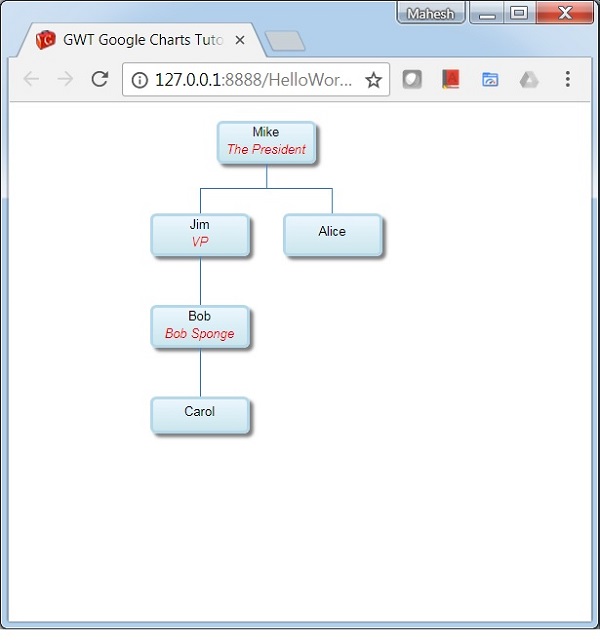GWT Google Charts - Organigramme
Voici un exemple d'organigramme.
L'organigramme permet de rendre une hiérarchie de nœuds, utilisée pour décrire les relations supérieurs / subordonnés dans une organisation. Par exemple, un arbre généalogique est un type d'organigramme. Nous avons déjà vu les configurations utilisées pour dessiner un graphique dans le chapitre Syntaxe de configuration de Google Charts . Voyons maintenant un exemple d'organigramme.
Configurations
Nous avons utilisé OrgChart classe pour afficher un organigramme.
// Organization chart
OrgChart chart = new OrgChart();Exemple
HelloWorld.java
package com.tutorialspoint.client;
import com.google.gwt.core.client.EntryPoint;
import com.google.gwt.user.client.ui.RootPanel;
import com.googlecode.gwt.charts.client.ChartLoader;
import com.googlecode.gwt.charts.client.ChartPackage;
import com.googlecode.gwt.charts.client.ColumnType;
import com.googlecode.gwt.charts.client.DataTable;
import com.googlecode.gwt.charts.client.format.PatternFormat;
import com.googlecode.gwt.charts.client.orgchart.OrgChart;
import com.googlecode.gwt.charts.client.orgchart.OrgChartOptions;
public class HelloWorld implements EntryPoint {
private OrgChart chart;
private void initialize() {
ChartLoader chartLoader = new ChartLoader(ChartPackage.ORGCHART);
chartLoader.loadApi(new Runnable() {
public void run() {
// Create and attach the chart
chart = new OrgChart();
RootPanel.get().add(chart);
draw();
}
});
}
private void draw() {
// Prepare the data
DataTable dataTable = DataTable.create();
dataTable.addColumn(ColumnType.STRING, "Name");
dataTable.addColumn(ColumnType.STRING, "Manager");
dataTable.addColumn(ColumnType.STRING, "ToolTip");
dataTable.addRows(5);
dataTable.setValue(0, 0, "Mike");
dataTable.setValue(0, 1, "");
dataTable.setValue(0, 2, "The President");
dataTable.setValue(1, 0, "Jim");
dataTable.setValue(1, 1, "Mike");
dataTable.setValue(1, 2, "VP");
dataTable.setValue(2, 0, "Alice");
dataTable.setValue(2, 1, "Mike");
dataTable.setValue(2, 2, "");
dataTable.setValue(3, 0, "Bob");
dataTable.setValue(3, 1, "Jim");
dataTable.setValue(3, 2, "Bob Sponge");
dataTable.setValue(4, 0, "Carol");
dataTable.setValue(4, 1, "Bob");
dataTable.setValue(4, 2, "");
PatternFormat format = PatternFormat.create("{0} {1}");
format.format(dataTable, 0, 2);
// Set options
OrgChartOptions options = OrgChartOptions.create();
options.setAllowHtml(true);
// Draw the chart
chart.draw(dataTable, options);
chart.setWidth("400px");
chart.setHeight("400px");
}
public void onModuleLoad() {
initialize();
}
}Résultat
Vérifiez le résultat.
